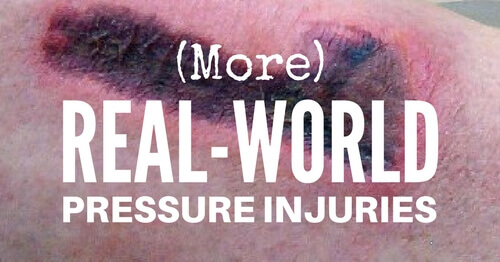More real-world wound care questions and answers relating to pressure injury staging, including slough, debridement and skin breakdown.
Can’t get enough of pressure injury staging? Neither can we. That’s why we’re excited to present even more questions and answers about this topic, based on what wound clinicians experience out in the field (versus what we might learn from textbooks or in a classroom).
In our first such post – packed with some awesome pressure injury staging questions from the field – we discussed slough, levels of destruction and debridement. Here, you’ll find out more about pressure injury staging as it relates to abrasions, surgical flaps, skin breakdown due to clothing, and more. So here they are – five more tips for staging pressure injuries, based on real questions from clinicians.
Question: I know that friction and shearing contribute to pressure injury development, but when do I stage it? For example, if a patient’s elbow rubs across the surface of the bed and it results in missing epidermis, is this now an abrasion or a Stage 2 Pressure Injury?
Answer: The situation you describe would be an abrasion. Incidentally, it’s worthwhile to consider the role of friction and pressure injuries. Friction force occurs when two objects rub against each other. Friction isn’t a direct cause of pressure injuries, but can contribute to shear stresses in skin and in deeper tissue layers which, in combination with pressure, results in pressure injuries.
Q: A patient’s waistband dug into his side and caused skin breakdown. Is this considered a pressure injury?
A: Yes. Pressure, along with friction from the constriction of the waistband, is most likely the cause of the skin breakdown. This would be considered a pressure injury.
Q: A patient has a cast or device removed and there is skin breakdown underneath. Is this a pressure injury?
A: Yes, this would be considered a Medical Device Related Pressure Injury, and would need to be staged using the staging system according to depth of the tissue destruction. For a more detailed discussion (and an education credit), view the WCEI webinar “Medical Device and Moisture Associated Skin Breakdown.”
Q: My patient has a pressure injury that is 100% filled with slough, and I’ve determined it’s unstageable. In addition to documenting length and width, should I also try to determine a depth? Can you technically have a depth that is 0.1 cm?
A: It can be difficult to measure depth in superficial partial-thickness injuries or wounds covered with slough. If the depth is less than 1 mm, document as < 0.1 cm. If a wound is open, it will have depth, because at least the epidermis has been penetrated. The epidermis has a thickness of 0.1 to 0.6 mm, and the dermis thickness can range from 2 to 4 mm.
Q: Can pressure injury staging be used for venous ulcers?
A: No. The National Pressure Ulcer Advisory Panel and European Pressure Ulcer Advisory Panel state that a pressure injury classification system can’t be used to describe tissue loss in wounds other than pressure injuries.
Q: If a Stage 4 Pressure Injury is repaired with a surgical flap, would it still be a Stage 4 or would it be unstageable?
A: According to the Centers for Medicare & Medicaid Services (CMS), if a muscle flap, skin advancement flap, or rotational flap is performed to surgically replace a pressure injury, the area is considered a surgical wound and is no longer a pressure injury. If the flap fails, continue to code the area as a surgical wound until it’s healed.
What are your questions?
Everyone who’s been out in the wound care field knows that there’s no better education than those real-world experiences. We’re sure there are more questions out there just waiting to be answered. Please ask them here! What challenges or wound care questions do you wrestle with in your facility? And do you have the answers? Post them below … we might use them for a future blog!
Wound Care Education Institute® provides online and onsite courses in the fields of Skin, Wound, Diabetic and Ostomy Management. Health care professionals who meet the eligibility requirements may sit for the prestigious WCC®, DWC® and OMS national board certification examinations through the National Alliance of Wound Care and Ostomy® (NAWCO®). For more information see wcei.net.
What do you think?

